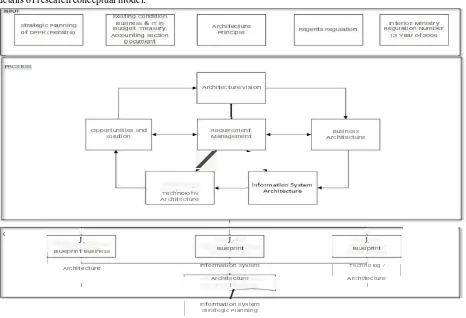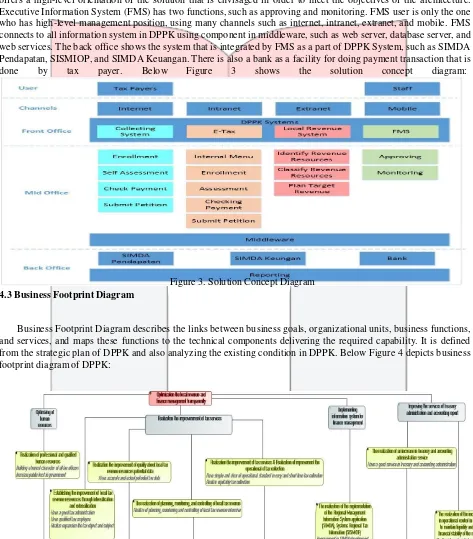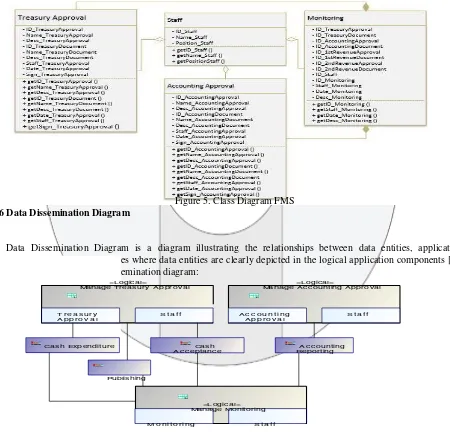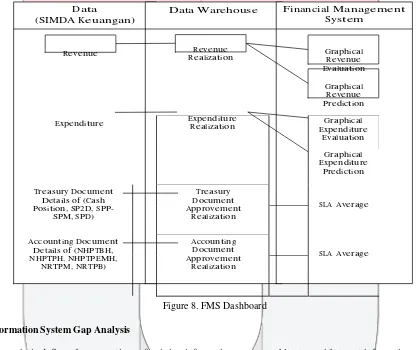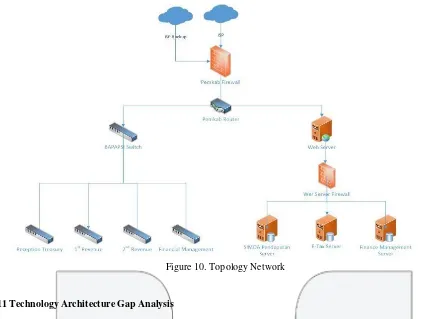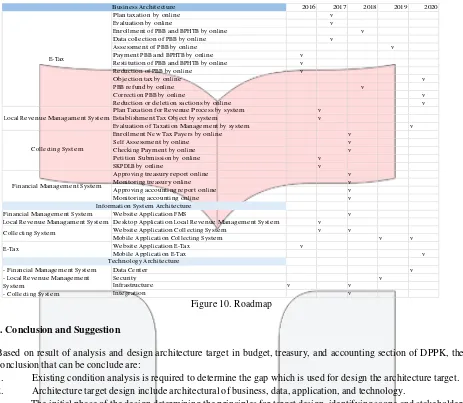INFORMATION SYSTEM STRATEGIC PLANNING BASED ON TOGAF ADM
FRAMEWORK IN BUDGET, TREASURY, AND ACCOUNTING FUNCTION
OF REVENUE AND FINANCIAL MANAGEMENT DEPARTMENT BANDUNG
REGENCY
Almareta Harasti Nuraini1, Yuli Adam Prasetyo2, Ridha Hanafi 3
1,2,3Information System Department, Industrial Engineering Faculty, Telkom University
1[email protected], 2[email protected], 3[email protected]
Abstract
Revenue and Financial Management Department (DPPK), a part of Bandung Regency Government, is a public oriented enterprise that engaged in financial world. DPPK needs to improve their information technology (IT) usage for upgrading Indonesia e-Government Ranking. For carrying out IT usage, DPPK needs information system strategic planning that is supported by enterprise architecture (EA) concept. By designing enterprise architecture using TOGAF ADM framework, DPPK has long-term information system strategic planning that align with its business strategy. This result can be useful to optimize IT resource that support business activities, in order to achieve goal and objective based on the vision and mission of DPPK.
Keywords: information system strategic planning, enterprise architecture, TOGAF ADM
1. Preliminary
The development of the era of IT into the era of data technology, is a phenomenon that is quite interesting for people to prepare taking a new step. In this transitional period, the use of IT is still tend to be done for every organization, whether profit-oriented and public service-oriented. One use of IT in government agencies could be seen with their e-Government, its the use of IT to support government services and operations [1]. Based on e-Government Directorate, 2014, the average value of Indonesian e-Government Ranking (PEGI) Bandung Regency Government in 2014, is 2.43 [2]. This indicate that the performance ratings of Bandung Regency Government in using IT is still included in the poor category.
Bandung Regency Government try to increase ITusage in operational case starting on a small scale, such as the regional working units (SKPD) such as DPPK. In accordance with current conditions, DPPK has implemented IT to support business activities. Application named SIMDA Keuangan used in Budget, Treasury, and Accounting Deputy. According to the results of observations in DPPK, the existing business processes in budget, treasury, and accounting deputy can be supported by SIMDA Keuangan. It is intended to help financial management process, especially on transactional level that can produce standard financial document. It still can not support the managerial functions, such as monitoring and approving processes. From the mentioned problem, it can be concluded that DPPK requires information systems strategic planning, aligned with business strategy and IT. Therefore, DPPK requires IT Master Plan as one form of strategic planning.
In order to create a strategic information systems plan, EA concept is needed to develop an integrated IT usage. A framework is also needed as a basis for managing complex information systems. Appropriate framework to be implemented in the case of DPPK is The Open Group Architecture Framework (TOGAF), by following the phase in the Architecture Development Method (ADM). TOGAF ADM chosen because it has a flexible nature, can adjust to the changes and needs during the design conducted. And phase for strategic planning of the TOGAF ADM was very detailed, so that DPPK would be easy to understand clearly.
2. Study Literature
2.1 Information System Strategic Planning Concept
2.2 Enterprise Architecture Concept
According to The Open Group, Enterprise Architecture is a description of the stakeholder mission that included information, functionality, location, organization, and performance parameters. EA describes plans to build a system or set of systems. Zachman defines EA as a blueprint of relationships mapping between components and all the people working in the company consistently to improve cooperation and coordination between them. So it can be seen that it is a concept for planning, designing, and managing information systems where IT can meet the needs of business in the organization. If there has been a harmony between business and IT resources, it is no longer a gap in the development of EA.
2.3 TOGAF ADM
TOGAF is a set of principles to be found in the value of an organization to be relied upon in making architectural and planning decisions, develop policies, procedures, and standards. Alignment between business goals with IT capabilities is importance key in defining the principles on TOGAF. TOGAF confirms that the principles is numerous, future-oriented, and approved by the top level management. TOGAF consist of 4 main architecture domain [3], such as :
1. The Business Architecture which defines the business strategy, management, organization, and key business processes in the organization.
2. The Application Architecture which provides the blueprint for am applications system to be deployed, the interaction between the application system, and its relationship to the main business processes in the organization. 3. The Data Architecture which explains the structure of the logical and physical data assets of the organization and
management of data sources associated with each other.
4. The Technology Architecture which describes the hardware, software, and network infrastructure required to support the deployment of main applications.
TOGAF Architecture Development Method (ADM) is important feature that enable company to defines business requirement and build specific architecture to meet the needs. ADM form an iterative cycle for the entire process, between phases and in each phase which every iteration new decision should be taken. The decision is intended to determine the extent of enterprise scope, level of detail, time targets to be achieved and architectural assets that is explored in the enterprise continuum. ADM is a common method so that if necessary in practice, ADM can be adjusted to the particular specific needs, for example, combined with other frameworks that ADM produces specific architecture to the organization. Figure 1 describes TOGAF ADM which consist of stages to build an enterprise architecture:
I
I
This research uses TOGAF ADM as a method to make information system strategic planning using EA approach. It starts from Phase A until Phase E, the method is defined by research conceptual model. Below Figure 2 shows the details of research conceptual model: activities that an organization carries out to create value for public. DPPK is the organization that focus for the taxation management and financial management of Bandung Regency. The primary activities in government is public services, so the primary activities in DPPK just focus in public services which is in taxation service. For the financial management in DPPK placed in support activities that related with internal of Bandung Regency. This figure below show the value chain of DPPK carries out their value to the public:
4.2 Solution Concept Diagram
Solution concept diagram is another output from architecture vision phase that show the concept of solution which offers a high-level orientation of the solution that is envisaged in order to meet the objectives of the architecture. Executive Information System (FMS) has two functions, such as approving and monitoring. FMS user is only the one who has high-level management position, using many channels such as internet, intranet, extranet, and mobile. FMS connects to all information system in DPPK using component in middleware, such as web server, database server, and web services. The back office shows the system that is integrated by FMS as a part of DPPK System, such as SIMDA Pendapatan, SISMIOP, and SIMDA Keuangan. There is also a bank as a facility for doing payment transaction that is done by tax payer. Below Figure 3 shows the solution concept diagram:
4.3 Business Footprint Diagram
Figure 3. Solution Concept Diagram
Business Footprint Diagram describes the links between business goals, organizational units, business functions, and services, and maps these functions to the technical components delivering the required capability. It is defined from the strategic plan of DPPK and also analyzing the existing condition in DPPK. Below Figure 4 depicts business footprint diagram of DPPK:
Figure 4. Business Footprint Diagram 4.4 Business Architecture Gap Analysis
components and business servic Below Figure 6. Shows data diss
objective. Below is the Table 1. depicts business architecture gap analysis: Table 1. Business Architecture Gap Analysis
4.5 Class Diagram
Class diagram describes the static structure of the symbols in new system named Executive Information System. This model allows graphically represent symbol diagrams containing classes. Below Figure 5. Depicts class diagram:
4.6 Data Dissemination Diagram
Figure 5. Class Diagram FMS
Data Dissemination Diagram is a diagram illustrating the relationships between data entities, application es where data entities are clearly depicted in the logical application components [3]. emination diagram:
<Logic al>
Manage Tr eas ur y A ppr ov al
<Logic al>
Manage A c c ount ing A ppr ov al
T r e a s u r y A p p r o v a l
S t a f f A c c o u n t i n g A p p r o v a l
S t a f f
Cas h Ex penditur e Cas h A c c eptanc e
A c c ounting Repor ting
Publis hing
<Logic al> Manage Monitor ing
M o n i t o r i n g S t a f f
Expenditure Expenditure Realization Graphical
Financial Management System Dashboard shows how is it worked in order to do integration with other application in DPPK. There is database of SIMDA Keuangan that have data entities and related with FMS. In data warehouse those data become to another form, so it can be used by FMS. FMS can monitor and approve treasury document, show graphical treasury report summary and trend analysis about revenue and expenditure. FMS can monitor and approve accounting document, show graphical treasury accounting summary and trend analysis about journal, adjustment, and trial balance. Below Figure 8 shows FMS architecture:
Data
Gap analysis defines the comparison of existing information system architecture with target information system architecture, in order to find the gap between them. It can show the required solution after analyzing the gap. It can give an overview to high level management to determine whether DPPK has the resources to meet the vision, mission, goal, and objective. Below is the Table 2 depicts information system architecture gap analysis:
Table 2. Information System Architecture Gap Analysis
4.9 Topology Network
Figure 10. Topology Network
4.11 Technology Architecture Gap Analysis
Gap analysis defines the comparison of existing technology architecture with target technology architecture, in order to find the gap between them. It can show the required solution after analyzing the gap. It can give an overview to high level management to determine whether DPPK has the resources to meet the vision, mission, goal, and objective. Below is the Table V.18 depicts information system architecture gap analysis:
Table 3. Technology Architecture Gap Analysis
4.12 Roadmap
Business Architecture 2016 2017 2018 2019 2020
Restitution of PBB and BPHTB by online v
Reduction of PBB by online v
Objection tax by online v
PBB refund by online v
Correction PBB by online v
Reduction or deletion sactions by online v
Local Revenue Managament System
Plan Taxation for Revenue Process by system v
Establishment Tax Object by system v
Evaluation of Taxation Management by system v
Collecting System
Enrollment New Tax Payers by online v
Self Assessment by online v
Checking Payment by online v
Petition Submission by online v
SKPDLB by online v
Financial Management System
Approvi ng treasury report online v
Monitoring treasury online v
Approvi ng accounting report online v
Monitoring accounting online v
Information System Architecture
Financial Management System Website Application FMS v
Local Revenue Managament System Desktop Application Local Revenue Management System v
Collecting System Website Application Collecting System v v
Mobile Application Collecting System v v
E-Tax Website Application E-Tax v
Mobile Application E-Tax v
Based on result of analysis and design architecture target in budget, treasury, and accounting section of DPPK, the conclusion that can be conclude are:
1. Existing condition analysis is required to determine the gap which is used for design the architecture target. 2. Architecture target design include architectural of business, data, application, and technology.
3. The initial phase of the design determining the principles for target design, identifying scope and stakeholders, and defining the overview of DPPK solutions.
4. The design of business architecture target includes the identification actor or anyone who is involved with the system, the business services, the relationship between actor with their role and business functions, business interaction between business services provided in all functions of DPPK, the identification requirement based on the goals, objectives and drivers and make business process improvement to meet specific business requirements.
5. Target design of data and application architecture depends and suits with target business architecture. 6. Target design of technology architecture depends and suits with target data and application architecture. 7. Designing roadmap in three years ahead to complete strategic information system planning based on TOGAF
ADM Framework.
Suggestions are given based on the results of the design and analysis has been done are:
1. For DPPK staff, especially in budget, treasury, and accounting section, are expected to maintain their performance in using SIMDA Keuangan which supports their business process.
2. For DPPK organization is expected to implement all of this information system strategic planning.
3. For further research are expected to do a research for implementing the strategic information system planning in DPPK based on TOGAF ADM Framework.
5. Bibliography
[1] Palvia, S. C., & Sharma, S. S. (2007). E-Government and E-Governance: Definitions Domain Framework and Status around the World. International Journal of Electronic Governance, 1-12.
[2] Direktorat e-Government. (2014). Pemeringkatan e-Government Indonesia. Retrieved November 2015, from http://pegi.layanan.go.id/tabel-hasil-pegi-4/
![Figure 1. Cycle of TOGAF ADM[1]](https://thumb-ap.123doks.com/thumbv2/123dok/3039299.1716915/2.596.118.483.421.769/figure-cycle-of-togaf-adm.webp)
